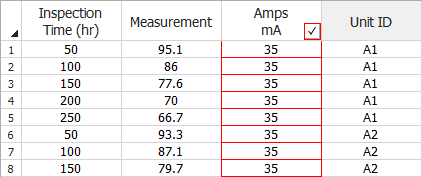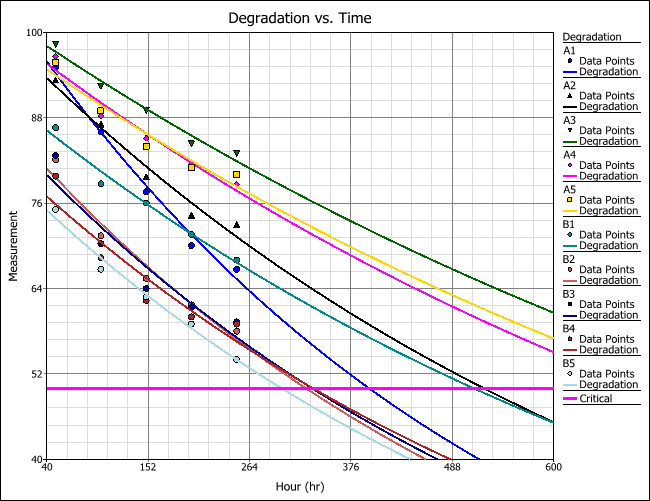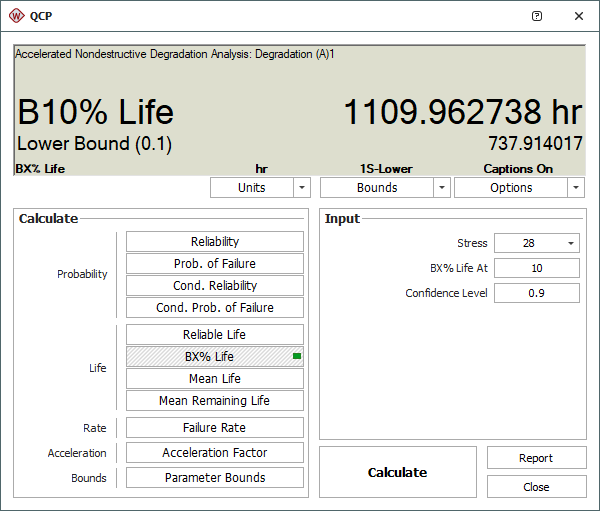Accelerated Life Testing Degradation Analysis Example
For life-stress data only.
A manufacturer of LEDs wants to determine, with 90% confidence, whether the B10 life of the LED is at least 700 hours. During operation, the light intensity of the LED diminishes over time, and for present purposes the level at which an LED can be considered failed (i.e., the critical degradation level) is 50 mcd. The LEDs normally operate at a stress level of 28 mA, but it would take too long for units tested at this stress level to decrease to a light intensity of 50 mcd. So it is decided to perform an Accelerated Life Testing degradation analysis.
5 units were tested at 35 mA, and 5 were tested at 40 mA. The light intensity of each unit was recorded five times, at 50 hour intervals, as shown next.
|
Inspection Time (Hr) |
Unit A1 |
Unit A2 |
Unit A3 |
Unit A4 |
Unit A5 |
|
50 |
95.1 |
93.3 |
98.3 |
96.6 |
95.8 |
|
100 |
86.0 |
87.1 |
92.4 |
88.2 |
89.0 |
|
150 |
77.6 |
79.7 |
89.0 |
85.1 |
84.0 |
|
200 |
70.0 |
74.3 |
84.3 |
81.4 |
81.0 |
|
250 |
66.7 |
73.0 |
83.0 |
78.6 |
80.0 |
|
Inspection Time (Hr) |
Unit B1 |
Unit B2 |
Unit B3 |
Unit B4 |
Unit B5 |
|
50 |
86.6 |
82.1 |
82.7 |
79.8 |
75.1 |
|
100 |
78.7 |
71.4 |
70.3 |
68.3 |
66.7 |
|
150 |
76.0 |
65.4 |
64.0 |
62.3 |
62.8 |
|
200 |
71.6 |
61.7 |
61.3 |
60.0 |
59.0 |
|
250 |
68.0 |
58.0 |
59.3 |
59.0 |
54.0 |
Create an Accelerated Nondestructive Degradation Analysis Folio
- Choose Home > Insert > Degradation. In the Add Degradation window, select the Accelerated Nondestructive Degradation option and click Next.
- In the setup window, select the first check box in the Stress Name column and rename the stress to "Amps," then enter mA in the Stress Units column and 28 in the Use Level column. Click OK to create the folio.

- Enter the given data into the data sheet. As an example, the data for units A1 and A2 are entered as shown next.

Analyze the Data Set
- In the Degradation Model area of the control panel, select Exponential from the drop-down list and enter 50 in the Critical Degradation area. In the Model area, select the IPL-Weibull model (i.e., the inverse power law life-stress relationship combined with the Weibull life distribution) from the drop-down list.
- Click the Calculate icon. The software will predict the failure time for each unit under the specified accelerated stress conditions, and it will perform an accelerated life testing data analysis on those failure times in order to extrapolate to normal use conditions. To view a plot of the results click the Plot icon.
The Degradation vs. Time plot shows how the performance of each unit ID degrades over time. You can select to plot the data points on a linear or logarithmic scale. The following example shows the linear scale plot. The pink line at the bottom of the plot marks the critical degradation level that was specified on the control panel.

- To view the parameters of the chosen degradation model and the extrapolated failure/suspension times, return to the data sheet. On the control panel, click Degradation Results (...). The parameters of the degradation model for each unit ID are displayed in the first data sheet of the Results window while the extrapolated failure times for all units are displayed in the second sheet.
- To view the results of the accelerated life testing data analysis, close the Results window and click ALTA Results (...) on the control panel.
Estimate the B10 Life
- To estimate the time at which 10% of units are expected to fail under normal conditions, open the QCP by choosing Life-Stress Data > Analysis > Quick Calculation Pad or by clicking the icon on the Main page of the control panel.
![]()
- In the QCP, choose to calculate the BX%
Life with Lower One-Sided
confidence bounds. Select Hour
for the time units and then make the following inputs:
- BX% Life At = 10
- Confidence Level = 0.9
- Click Calculate to obtain the results. The results show that the B10 life of the LED is estimated to be 1109.9328 hours. The lower one-sided 90% confidence bound is estimated to be 737.7939 hours. Thus, the LED meets the manufacturer's requirement.
